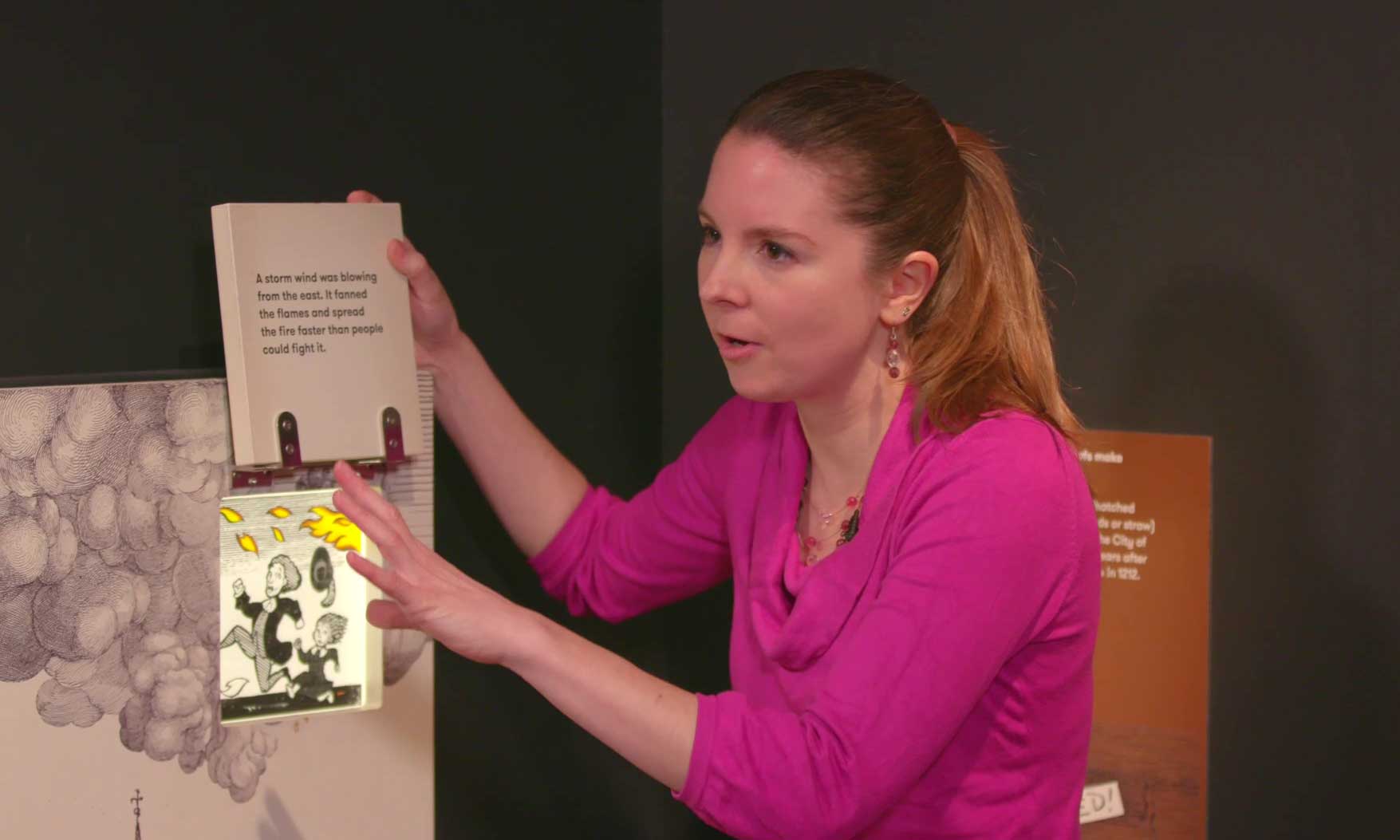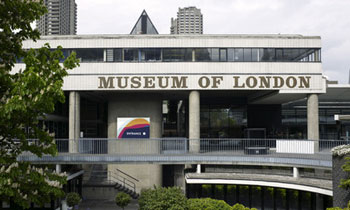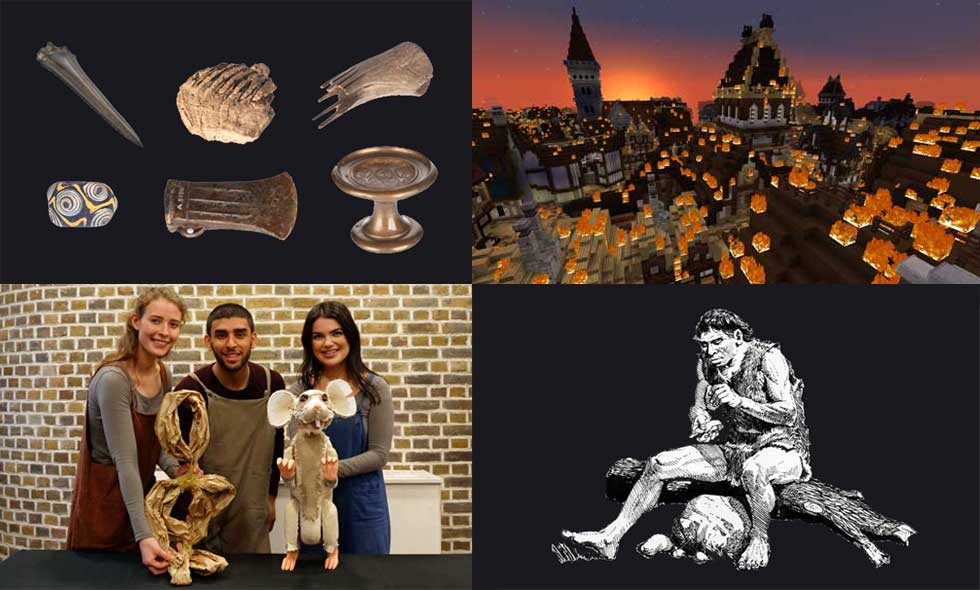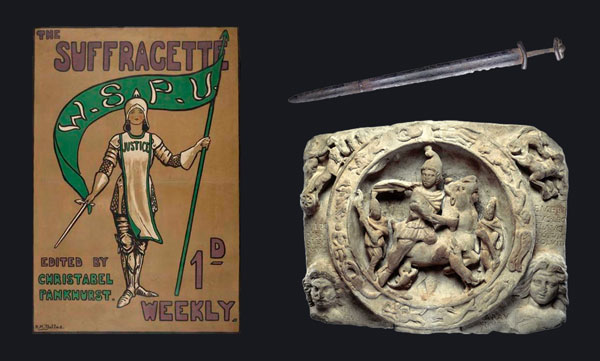Great Fire of London live stream: Part 1 - Full transcript
Get the transcript of our popular Great Fire of London live stream! Part 1 explores how the fire started and why it got so bad.
[stream begins]
[00:01:08]
Marina:
Hello and welcome to this live stream from the Museum of London! We should have schools and families joining us today, so I’d like to extend a warm welcome to all of you.
My name is Marina and I’ll be your host for today and joining us we have Meriel Jeater. Meriel is a curator at the museum and our expert on the Great Fire of London.
[00:01:31]
Meriel:
Hi everyone!
[00:01:33]
Marina:
Now, we’ll be having a little Q&A with Meriel later, so get thinking about some of the questions you might want to ask her about why the Great Fire started. But before we get going, we have some important things to tell you.
Firstly, this is the very first time we are streaming live from our homes. So, there might be a few hitches, technical hitches, so please do bear with us.
Secondly, please make sure you have an adult with you during the stream and encourage them to get involved as well!
If you are watching via Facebook, please make sure that your profile has your preferred privacy settings before you comment. We aren’t responsible for what is said in the comments, but we do encourage you to be very sensitive to others. And if you do comment on the stream, remember that the message and the account name will be visible to the public.
Now adults! It’s up to you to type in questions and remember not to share any personal information with us, including children’s first names or photos of them. But we hope that you can hear and see us clearly. So do give us a like or a comment on Facebook to let us know it’s all working!
[00:02:51]
Now, today is the first of our three-part series looking at the Great Fire of London.
Each day we’ll be giving you a short tour through an exhibition we made about it called Fire! Fire! with actions and activities that you can do together.
The theme for your tour today is ‘What started the fire and how did it spread?’ After your tour we’ll give you an extra three minutes of thinking time to talk to each other about what you’ve seen and heard and share any questions you have about it with us in comments in Facebook.
Meriel:
Then, I will answer some of your questions live!
Now if we’re lucky, we’ll get lots of great questions from you all, so I won’t have time to answer them all face-to-face. But we’ll do our best to reply to you in the Facebook comments afterwards.
And if you’re really keen, and are looking for something fun to do afterwards, we’ll even suggest an exciting activity for you to do at the end.
Marina:
So what are we waiting for? Are you ready for that special tour? Then let’s get started! My colleague Nina will show you around.
[00:04:03]
Nina:
Hello Meriel!
Meriel:
Hi Nina!
Nina:
So, can you tell us about what a curator does?
Meriel:
So, for this exhibition, I read a lot of books to find out what happened in the Great Fire, I chose the objects, and helped to put the exhibition together. So today I’m going to be showing you around the exhibition so we can investigate the fire, what happened and how London changed.
[00:04:23]
Nina:
So, this represents what London looked like before the Great Fire started?
Meriel:
Yes, so this is a typical London street before the fire, so it’s narrow, it’s dark, the upper floors of the houses are leaning out into the street which makes it narrower and easier for fires to spread. And of course, the Great Fire began on a narrow street like this, called Pudding Lane. So, if you come with me, I can show you how the fire started.
[00:04:53]
Meriel:
The Great Fire started in Thomas Farriner’s bakery on Pudding Lane at about one o’clock in the morning. We don’t know exactly how the fire began, but we think maybe a spark from his oven set fire to some wood next to it and then the family were woken up with the smoke coming up the stairs. So, Thomas, his daughter Hanna and their manservant escaped out of the window upstairs. But their maid was too frightened to jump out and so we think she was the first person to die in the fire. So, this fire that just starts in a bakery, ends up destroying a quarter of London in four days.
[00:05:34]
Nina:
Imagine that for a moment. Perhaps you would like to act it out where you are sitting.
Imagine waking up in the middle of the night to feel smoke in your face and to hear the burning sounds. Imagine having to climb out of the window on the street to escape and then, having to wake up your neighbours. Maybe you’d shout together “Help! Fire! Help! Wake up! Wake up!”
Ok, let us go through now to see how the fire spread.
[00:06:08]
Meriel:
So, you can see the fire beginning in Pudding Lane on Sunday the 2nd of September. And there was this huge storm wind that was blowing in from the East, which pushed the fire across the city. So, you can see the direction that the fire is spreading across this map.
[00:06:32]
Meriel:
This is Tuesday the 4th of September, which is the worst day of the fire. And this is when some of the most famous buildings are destroyed, like St Paul’s Cathedral. By the end of Tuesday, the fire was a mile and a half wide. So, it would take you half an hour to walk from one side of it to the other.
[00:06:50]
Meriel:
On Wednesday, the wind died down, and that’s when people started to be able to finally get control of the fire. And then by the time the sun comes up on Thursday morning, the fire is out. Though some places actually smouldered for months afterwards.
[00:07:08]
Nina:
Why do you think the fire got so bad?
I’m going to give you 30 seconds now to discuss this with someone next to you, before Meriel tells you some of the reasons that we think are responsible.
[30 second countdown clock begins]
[00:07:53]
Nina:
So, let’s see if you thought of a lot of the reasons that we have about why the fire got so bad.
Meriel:
Well, here we have a symbol of the moon, and that’s to show that the fire started in the middle of the night when most people are asleep. So, there weren’t enough people around to stop it right at the beginning.
[00:08:13]
And here we have a picture of the sun, because the fire began at a time at the end of a long hot summer. So, London was really dry.
[00:08:23]
And then this, we’ve got a picture of the wind. And that’s because there was this huge storm wind blowing from the East that night and it pushed the fire across the city.
[00:08:34]
And then down here, we’ve got buildings. And that’s because a lot of the houses in London were made from wood and that burns easily.
[00:08:42]
And also, lots of the houses were built very close together. So, it was easy for the fire to spread from one house to the next.
Nina:
Yes, of course.
[00:08:54]
Marina:
Well, we hope you enjoyed that. I certainly learned a lot!
Now’s your chance to have a good think and talk amongst yourselves about what you’ve seen and heard. And to share any questions that you have for us on the Facebook comments. I can’t wait to see what you come up with!
Now remember not to share any personal information, but if you’re in school, do let us know the name of your school and your class. And to focus your questions on what we’re learning today: how the fire started and why it spread.
[00:09:27]
You’ve got three minutes to think and share your questions on Facebook. Go!
[three-minute countdown clock begins]
[00:12:42]
Marina:
Welcome back!
We’ve had some amazing questions come through so without further ado, let’s get answering them.
So, our first question for you Meriel comes from Sarah Smith. She says, “Could the fire have been started deliberately?”
[00:13:02]
Meriel:
Well that was one of the theories at the time, and in fact they had an investigation after the fire to look at how it might have been started and Thomas Farriner the Baker, who owned the bakery where the fire began, always said that it was not his fault - the fire had been started deliberately - but actually there would have been no solid evidence that the fire was started on purpose, so we think it was probably an accident.
[00:13:25]
Marina:
Ok. And then Charlotte Walker asks “Did the baker get into trouble for starting the fire?”
[00:13:33]
Meriel:
Well maybe luckily for him a Frenchman called Robert Hubert was arrested fleeing the country and confessed to starting the Great Fire even though he probably had nothing to do with it whatsoever.
He seems to have been a little bit confused and he was hanged for starting the Great Fire, but the investigations into what caused the fire carried on after his death, actually, so he probably had absolutely nothing to do with it at all. But it did mean that the baker managed not to get into trouble.
[00:14:08]
Marina:
Thank you. And talking about the bakery, Sarah asks, “What type of food they would have been making in the bakery?”
[00:14:17]
Meriel:
Thomas Farriner had a contract to make ship biscuits for the navy, those are those kind of hard, salty biscuits that sailors have to eat on long voyages.
[00:14:27]
Marina:
I didn’t know that. Thank you Meriel. And... What else have we got here... So, Ali says, “Did they have a version of the fire service?”
[00:14:41]
Meriel:
There was no fire brigade in London in 1666 so if a fire started in your local area, you were supposed to get together with your neighbours to put it out and they did have communal fire fighting equipment that was kept in churches and things like that but we’re gonna be talking much more about that next week. Our next stream will be about how they fought the fire.
[00:15:03]
Marina:
I’m looking forward to that. So we’ve said the fire started in 1666. Michelle asks, “Was that during the plague?”
[00:15:03]
Meriel:
Well the plague was mostly over by the time the Great Fire happened so the Great Plague started in 1665 and while there were a few plague cases still happening in 1666, most of the plague was over by the time the fire started.
[00:15:30]
Marina:
And what else do we have... so Vicky says, “Was it common for fires to start in London in those days?”
[00:15:39]
Meriel:
Well, there have been many very serious fires in London’s history. In Roman times, in Medieval times, and probably one of the worst times was in 1212 in the Medieval period where over 3,000 people were estimated at the time to have died. It was a really, really terrible fire and after that they put in regulations so they banned thatch so that straw roofs of houses were banned and everyone had to have tiled roofs instead, which would help stop the spread of the fire. From 1212 to 1666 there wasn’t a really major fire but of course fires did occur.
[00:16:23]
Marina:
Ok, so quite a while then!
Meriel:
Yeah.
[00:16:26]
Marina:
Now you’ve mentioned thatch, but Amy Rose has a really good question, “Why did they build the houses so close together?”
[00:16:34]
Meriel:
That was because the London population were quite squashed inside the city walls so the oldest part of London inside the city wall, there were suburbs spreading around it but there was thousands of people trying to squash in the city, so they built their houses close together to fit as many people in as possible.
[00:16:56]
Marina:
And with all those people, there must have been a lot of rubbish...
And Paul Caroline says, “Did the rubbish spread around the streets help to carry the fire from houses to houses?”
[00:17:09]
Meriel:
Oh, that’s an interesting question!
I’m not sure whether rubbish in particular, mind you it may have had a role, certainly the wind would have made flaming bits fly through the air and they would land on houses a few streets away, that kind of thing would have helped the spread of the fire.
[00:17:31]
Marina:
It was really windy wasn’t it?
Meriel:
Pardon?
Marina:
It was really windy wasn’t it.
[00:17:37]
Meriel:
It was, I mean there was this huge storm blowing and the other thing was when they were pulling down houses to make these breaks in the fire to stop it from spreading any further, sometimes they didn’t do it quick enough and pull all the debris out of the way quick enough so the debris could catch on fire and then spread even further on. So it was really hard to put it out.
[00:18:01]
Marina:
Hmm, really great question there, very good! A question about context: Fiona says, “Who was the king or queen when the Great Fire started?”
[00:18:12]
Meriel:
It was King Charles II. He was king from 1660 so this was the sixth year of reign and he was very worried about London - he got very involved in fighting the fire himself.
[00:18:25]
Marina:
And another quite interesting question. Ashley says, “Are all the streets named after food?”
Meriel:
All the streets named after food?
Marina:
Pudding Lane...
[00:18:39]
Marina:
Oh actually quite a lot of the streets in London were named after foods or where you could buy certain things so Bread Street was had bakeries on it, Cheapside... we probably don’t have the same word for it anymore but 'cheap' meant 'market' so that was a street with market stalls on it. There are quite a lot of old street names in London which relate to what you could buy there.
[00:19:06]
Marina:
Wonderful. Let me see if we’ve got any other questions. So, how long did it take to put the fire out?
[00:19:17]
Meriel:
Good question, they were fighting the fire from kind of Sunday morning onwards but the real efforts to really put it out start on Tuesday and then the fire ends first thing on Thursday morning. So it’s about a day and a half when they’re actually, really putting the fire out and taking control over it.
[00:19:45]
Marina:
So a fair amount of time then. And how far did the fire spread?
[00:19:52]
Meriel:
So the fire spread from The Tower of London across in the east to Temple in the west, which is nearly two miles, so it would take you about half an hour to walk from one side of the fire to the other. It’s a huge area.
[00:20:10]
Marina:
Definitely. Ok, I’m just waiting for some more questions to come through.
Meriel:
Do you have one for me Marina?
Marina:
I do have one for you Meriel. So when I was young, I was always told that the Great Fire ended the Plague. Is that true?
[00:20:30]
Meriel:
No, that’s a myth. It’s just convenient timing. Actually if you look at a map of London that shows you the areas that were worst hit by the Plague, it’s a different area that burns in the Great Fire of London. So the myth is kind of that the fire cleanses the city and burns the Plague away but that’s not the case.
The Plague is worst in the suburbs and those are the areas that did not burn in the fire.
[00:21:01]
Marina:
Oh ok, that’s very interesting. There you go, what I thought when I was young, I’ve lost. Just a myth! We have a great question from Carly Buchanan, back to how the fire started. “Why did the baker fall asleep whilst he was still cooking?”
[00:21:19]
Meriel:
Oh well he went to bed that night and he sort of raked up his fires. He had left a burning ember behind so that it was easy to start the fires again the next morning. So it might be that a spark fell out of those burning embers, perhaps, but to be honest with you we don’t really know exactly how the fire began, we just know where it began.
[00:21:43]
Marina:
Oh, excellent. And John says, “Why do we call it the Great Fire?”
[00:21:51]
Meriel:
Oh, I guess because it was so huge! It’s like the Great Plague. Actually the Great Plague is not the worst plague outbreak in London’s history but it’s just the last one, and the Great Fire was kind of the last huge fire until we get to the Blitz in the 1940s.
[00:22:11]
Marina:
So that gives it it’s name of ‘Great’ then. Lynsey has asked, “How do we know that the family jumped out of the window that night?”
[00:22:22]
Meriel:
There’s a letter survives from the time which was written shortly after the fire by a guy called Sir Edward Harley, writing to his wife, and he’s sort of describing all the latest news from London, and he talks about how the fire begins and how the baker has to escape with his family and so on, so that’s where that bit of information comes from.
[00:22:45]
Marina:
Interesting. And I expect news like that spread quite quickly as well.
[00:22:50]
Meriel:
Exactly, everybody in London would have been talking about how it began, who’s lost what and what bits had burnt down, writing to their friends and relatives to tell them.
[00:23:02]
Marina:
Wonderful. Now we have so many questions - this is fantastic. So, one question, these are about future streams so perhaps you can answer quickly, Meriel. So where did people take shelter when the houses were on fire?
[00:23:20]
Meriel:
Well they fled out of the city and they set up temporary camps in the fields outside the city so there are some amazing descriptions in people’s diaries of the time, of thousands of Londoners sitting by heaps of all of their household belongings in the fields.
[00:23:35]
Marina:
That was a great question, we will definitely address it in future streams a little bit more as well. We’ve also got another from Lynsey. She asked, “How do we know that the maid was too scared to jump out of the window?”
[00:23:54]
Meriel:
That’s also in that letter that I described by Edward Harley to his wife, so he talks about how the maid was too scared and was burnt in the house. Thomas Farriner, his daughter Hanna and their manservant were able to escape but that same letter described Hanna as being very scorched, so she must have got burnt herself but was able to escape.
[00:24:19]
Marina:
It must have been very scary.
[00:24:21]
Meriel:
Yeah, totally terrifying.
[00:24:24]
Marina:
Another question, “How many buildings were destroyed by the fire?”
[00:24:30]
Meriel:
Records from the time say 13,200 houses died. Died? I mean burnt. And 87 churches burnt down as well.
[00:24:42]
Marina:
Wow, so a huge swathe of London completely destroyed.
Meriel:
Yeah. About a quarter of the size of London at the time was burnt.
[00:24:55]
Marina:
Now I will get some more questions up. There are so many questions coming in that I’m needing to find them. Now this will be our very last question. So Meriel, you are a Curator - a really great question here from Fran, “What is your role as a Curator?”
[00:25:15]
Meriel:
I’ve got lots of different elements to my role. So a big part of it is working with colleagues about what we put on display in the museum in the main galleries, and also in the temporary exhibitions, so researching the collection. And when you go into the museum and you see the labels for all the objects, those are the sorts of things that curators write, so I write the text for temporary exhibitions, I research the objects in the collection, I do teaching. I help answering enquiries when people write to the museum when they’ve got a question about London history - I’m one of those people that replies to those questions.
It’s a really varied job, it’s really fun.
[00:25:55]
Marina:
It sounds like a great job! I’m very jealous, Meriel.
Now sadly that is all we have time to ask Meriel today but thank you so much for all of your fantastic questions.
[00:26:06]
Meriel:
Yes, they were really, really good questions.
[00:26:10]
Marina:
Now we will do our best to answer all of the questions that have come in on the Facebook comments that we haven’t managed to put to Meriel live, but Meriel will only be around until 3pm on Facebook.
[00:26:23]
Meriel:
And we’ve got one last thing for you. After each of our live streams we’ll be setting a challenge about what we’ve learnt in each one.
So your challenge this time is to get drawing!
So, do you remember the reasons why the fire got so bad?
Draw a picture of each of the reasons that you can think of. Can you draw more than three?
And then show them to your friends and family and your classmates and see if you’ve got some of the same ones or different ones and share them with us as well. If you want to share them with us, please do, but make sure that they’re pictures that you’ve drawn yourself. We really look forward to seeing them.
[00:27:03]
Marina:
And that's it! Thank you so much for joining us today and for all of the excellent questions and thoughts you’ve shared with us.
You'll be able to find the challenge which Meriel has described, plus watch the recording of today's stream, and tell us what you thought of it, on the museum website at museumoflondon.org.uk/fire
We hope you’ll join us again next week at the same time, and you’ll get a new tour and find out another part of the fire plus get another chance to ask us questions to Meriel.
[00:27:38]
Meriel:
Next time, it’ll be all about what people did during the fire and how it was eventually put out. We’ll even have some exciting fire-fighting equipment to show you!
[00:27:48]
Marina:
We can’t wait to see you then! And if you’ve enjoyed it as much as we have today, remember to share it with your friends and family and to join us next time. Goodbye!
Meriel:
Bye!
[stream ends]
The Great Fire of London Live Stream Part 1
Investigate how the fire started and why it got so bad.











